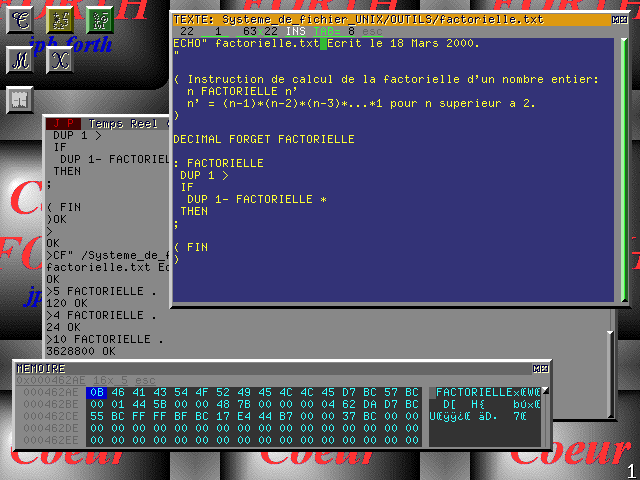


|
Introduction to
FORTH
Working in the National Look-out post of Radio astronomy of
the United States at the beginning of the 70s, Charles Moore was
charged to schedule the first minicomputers 16 bits (typify IBM
360) for the purchase of scientific data and the maintenance of
equipment.
The high-level languages of time as the FORTRAN (not to confuse
with the object of this paragraph) was too heavy for the execution
of real-time software packages. Machine language was, as for him,
indigestible enough to venture to realize always more complex
programs.
And so Charles MOORE had the idea to create a revolutionary
language the instructions of bases of which corresponded to a
single line of code in machine language.
This allowed not only to write programs in high-level language
with almost the performances of machine language but besides reducing
at most size memory which was extremely weak at the time.
Charles MOORE wanted to record his language under the name
of FOURTH for language of fourth generation but the computer which
he used authorizing only names of 5 letters, he called it: FORTH.
Well to understand and to use at most performances inferred
by the language FORTH, it is important to master inverted Polish
notation used also with calculators made by Hewlett-Packard. The
transmission of parameters makes essentially by a last in-firs
out stack. This notion is what allowed Charles Moore to pull the
maximum of performances of its language because it is necessary
to know that any processor deserving of this name possesses memory
manipulation instructions under shape of stack of this type.
Besides the classic stack of return from subroutines administered
intrinsically with most of the processors, the idea to use the
same instructions for parameters transfers drove to create a data
stack of which some basic instructions are the following ones:
- DUP piles the copy of the number being at the top of the
stack: n - > n, n (the summit of the stack is to the right),
- DROP depilates the number being at the top of the stack:
n - > - (line means that the stack is empty with regard to
the previous level),
- SWAP inverts the 2 numbers of the summit of the stack:
n1 , n2 - > n2 , n1
- OVER piles the copy of the number situated in the second
rank of the summit of the stack: n1 , n2 - > n1 , n2 , n1
- ...
Operations such as comparisons or additions will directly
consume the numbers situated at the top of the stack:
- > Compare the 2 numbers at the top of the stack and
leave a boolean: n1 , n2 - >-1 if n1 > n2 , 0 otherwise
- -Complete subtraction such as: n1 , n2 - > n1-n2
- * Signed complete reproduction such as: n1 , n2 - >
n1*n2
- ...
The most control basic structure is the set formed with IF,
ELSE AND THEN. IF tests the number at the top of the stack by
pulling it. If it is different from 0, instructions placed between
IF and ELSE are executed then program connects following the word
THEN. If it is zero, program connects directly in instructions
being following the word ELSE. Several structures of this type
can be obviously been linked.
In FORTH, all the instructions can be programs and mutually.
They are introduced into the memory according to their compilation.
Put in by some instructions which manipulate the return stack
as the structures of control for example, all the instructions
can be interpreted at any time what gives considerable opportunities
of settling for developers. Useless to write another main program
and to redo a compilation to see if it is subroutine which works
badly . It is enough to launch his execution with adequate parameters.
Instructions or programs or subroutines are inserted into
the memory with pointers' system which connect them among them
to allow the interpreter (or in the compiler according to the
mode of functioning) to find them. Search begins by leaving of
the last compiled instruction and by raising until the first which
is often DUP. If instruction does not exist, the interpreter /
compiler looks if it is a number and piles it at the top of the
stack in interpretation mode or compiles it in the instruction
in compilation mode. To create an instruction, one uses 2 instructions
(except those that describe the sequence to be executed):
- : Follow-up of the name of the instruction and which spends
from interpretation to compilation mode,
- ; Which ends instruction and so goes back in interpretation
mode.
Finally, not to be too exhaustive in this presentation, know
that FORTH language allows to write recurse procedures what makes
a really very evolved language of it. Here is the example of factorial
calculation program of an integer appealing to this notion of
recursion:
: FACTORIELLE
DUP 1 >
IF
DUP 1 - FACTORIELLE *
THEN
;
To illustrate this introduction in the language FORTH, here
is a screen presenting the development of this instruction:

The window of interpretation (in light gray) gives values
calculated by the factorials of 5, 4 and 10 after compilation
of the file contained in the window of edition (in blue). The
window of display of the memory (in dark gray) shows size occupied
by this instruction which is of 46 bytes.
To have more information on FORTH, I invite you to consul
the Page of links making reference to
the main sites of the net.
|
 |
 |





